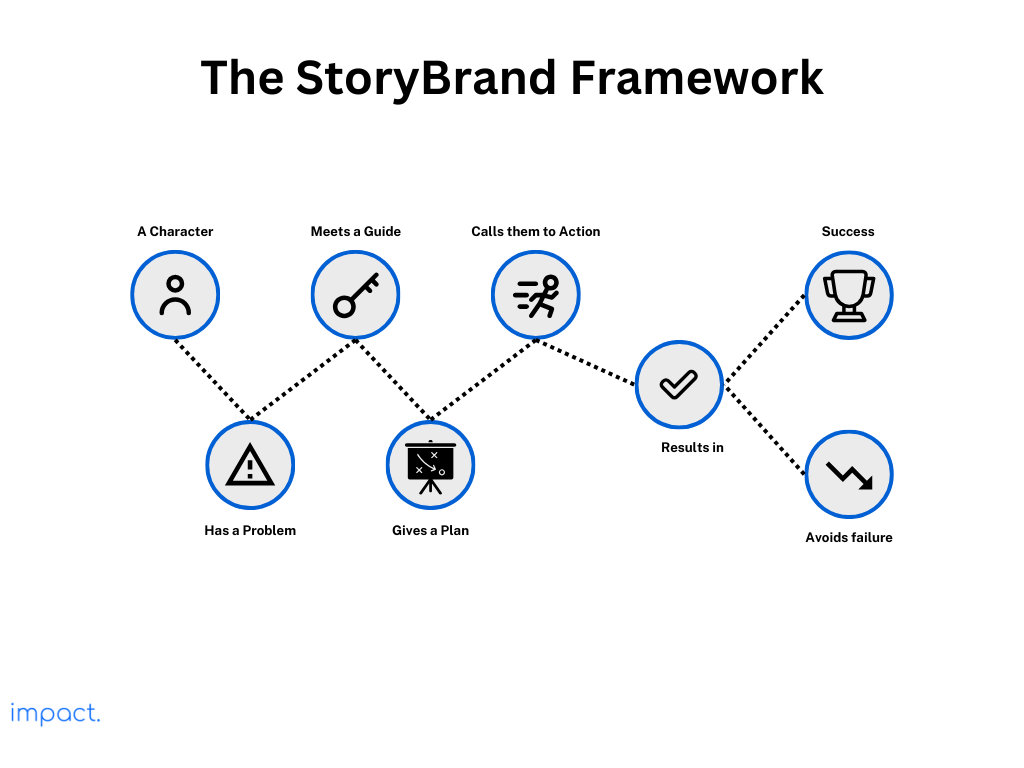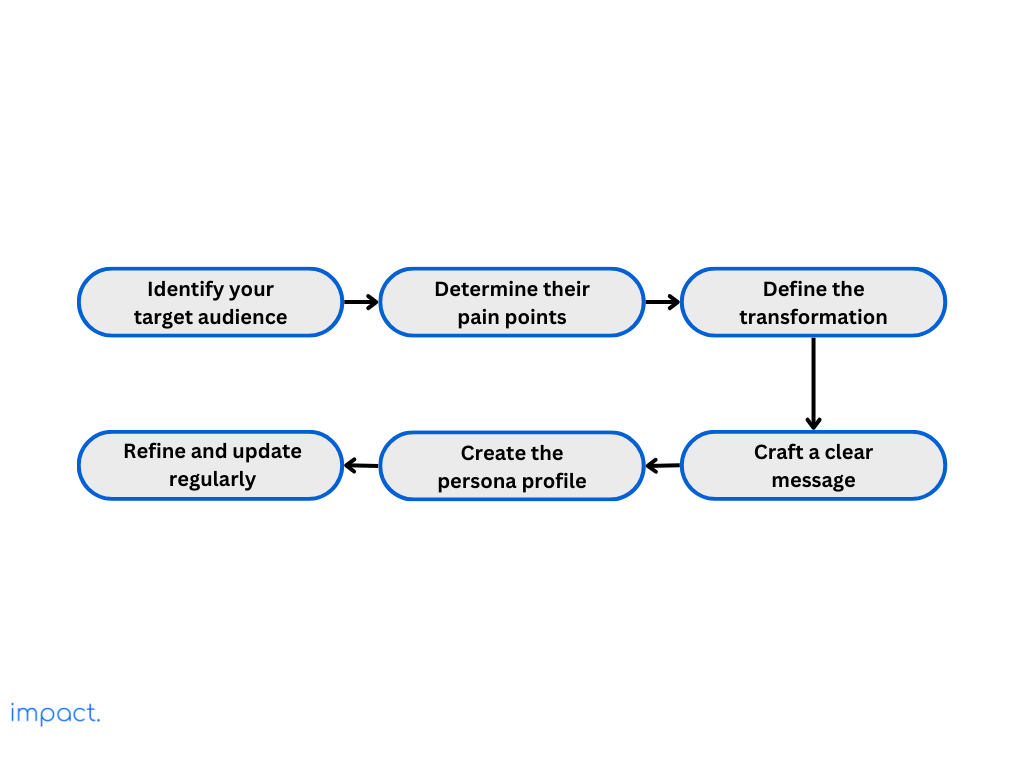Kanban: Definition, 6 Rules, and its Benefits
Kanban is a crucial part of the Just in Time (JIT) system, which we discussed…
Sean Thobias
May 17, 2025Traditional branding uses old marketing methods to build a strong brand image by highlighting company values, mission, and unique selling points. However, here’s the truth: customers are more interested in their stories than yours.
Create a strong brand using Donald Miller’s StoryBrand Framework by putting your customers at the center. Develop a buyer persona to connect emotionally with your target audience, uncover their needs, and effectively communicate why your product or service is meaningful to them.
The StoryBrand Framework is all about storytelling and how it naturally captivates people. According to Donald Miller, businesses should guide the customer’s story, with the customer as the hero. The framework has seven key elements:

The StoryBrand Framework aims to create a clear and compelling narrative that resonates with customers, making it easy for them to understand the value and take action. Businesses can improve communication and marketing effectiveness by simplifying the message and focusing on the customer’s journey.
A buyer persona is like a detailed profile of your perfect customer, created from actual data and market research. It shows background, behavior, preferences, pain points, and more, helping businesses target and understand their audience in marketing and sales.
Here are some standard components found in a buyer persona:
This part closely examines the buyer’s personal and professional details, like their job title, industry, company size, and location. Knowing their background helps customize marketing and products to match the buyer’s needs.
Identifiers are characteristics that help us identify a buyer quickly. There are three types:
Pain points are the issues and frustrations buyers face. Recognizing these challenges is essential for creating effective marketing messages and product solutions.
This understanding enables you to empathize with customers, highlight the value of your offerings, and position your brand as a problem solver. You can address these pain points directly and develop targeted solutions that meet the buyer’s needs.
Buyer personas give detailed information about your customers, what they do, and what they like. With this knowledge, you can create an effective marketing strategy that connects with your audience’s needs and preferences.
Recognizing and remembering your customers pays off. According to Accenture, 91% of consumers are more inclined to buy from brands that offer relevant offers and recommendations.
Companies often confuse customers by using different visuals and messages across platforms. Confusion can lead to missed opportunities for gaining new customers and growth and reduced loyalty.
Craft a brand message that directly addresses the concerns and aspirations of your target audience by using a buyer persona. It ensures your brand communication is relatable, emotionally appealing, and relevant.
Consistent branding is vital for business success. It boosts revenue growth for two-thirds of companies, with those maintaining consistency being 3.5 times more visible than those with an inconsistent brand.
Using a buyer persona helps unify your brand across different marketing channels. It ensures that your messaging, visuals, and tone align seamlessly, creating a solid and cohesive brand identity for your diverse audience.
Creating buyer personas is crucial for intelligent marketing. It helps you use your marketing budget wisely by concentrating on the customers that matter most.
Doing this saves time and effort, ensures your messages hit the right people, and boosts your marketing return on investment.

In the StoryBrand Framework, customers are the heroes of their own stories. To create a buyer persona, identify your target audience by understanding their demographics, psychographics, and behaviors.
For detailed insights, conduct market research and surveys and analyze customer data to gather relevant information.
Identify your customer’s exact problem – what they struggle with daily. Pain points are critical because it lays the groundwork for your brand to offer a solution.
Highlight the specific challenges and annoyances your target customer goes through, building a relatable link between them and your brand.
Outline how your product makes a positive impact on people’s lives. Envision the change they’ll go through — from their current situation to their desired state.
This transformation is at the heart of your product’s delivery, aligning with the StoryBrand Framework.
Craft a clear and engaging message showcasing how your product or service directly solves customer’s pain points, resulting in a positive transformation. Whether making a purchase, trying a trial, or reaching out, use persuasive language to prompt the customer to take that next step.
Keep it simple, skip the jargon, and keep the focus on the customer. Highlight the benefits explicitly and guide them through the process for a seamless experience.
Create detailed and realistic buyer personas by using the gathered information. Each persona should represent a specific group in your target audience.
Give your persona a name and a face (using stock photos), and include details about demographics, challenges, preferences, and buying behavior. This step humanizes your audience, making it easier for your team to relate to and understand your customers.
Keep your messaging in sync with your customer’s changing needs as the market evolves. Regularly update your personas to reflect your target audience’s ongoing journey and challenges.
Stay on top of industry trends, customer feedback, and market shifts that could affect your audience. This constant refinement ensures that your marketing and branding efforts stay relevant and effective.
Meet Alex Johnson, a 38-year-old entrepreneur who owns the small digital marketing agency “PixelCrafters.” With over a decade of experience in marketing, Alex ventured into entrepreneurship three years ago, offering tailored digital marketing solutions for small and medium-sized businesses aiming to enhance their online visibility.
Your product/service is a comprehensive digital marketing toolkit for small businesses like PixelCrafters. It offers:
Insufficient data can impede the development of precise buyer personas, leading to broad assumptions. Conduct comprehensive market research, surveys, and data analysis to remedy this.
Utilize customer feedback, analytics, and social media insights, and explore tools like ERP software to efficiently collect and organize data from various departments like sales, marketing, and customer service, providing a unified view of customer interactions and preferences.
Marketers often make a big mistake by relying on assumptions when creating buyer personas. Simply collecting anecdotes from your customer-facing team isn’t sufficient.
Without proper validation, these assumptions can result in inaccurate personas that don’t reflect your target audience’s behaviors and preferences. To avoid this, continually validate and refine your buyer personas using real-world customer interactions, sales data, and market feedback. Make adjustments based on actual results and performance metrics.
Negative buyer personas are profiles that tell you which people are unlikely to become customers. They’re the ones who don’t fit well with your company.
Create these negative personas to weed out leads that probably won’t become customers. It makes your marketing more focused, reaching only those likely to find value in your offer.
Don’t just focus on demographic information; it won’t make your personas stand out. You might miss essential psychographic and behavioral factors if you only consider demographics.
Think about your persona’s daily activities, media consumption, challenges, and how they measure success. Base your personas on this information to guide when and how you interact with your audience.
Having 4-5 personas is excellent, but having too many can harm your marketing. Personas are about representing different customers and enhancing their experiences based on who they are, what they value, and how they prefer to do business with you.
Group similar segments and prioritize personas based on their impact on your business goals and market potential. Quality matters more than quantity, so focus on the most impactful personas to optimize your marketing strategy.
Many businesses mistakenly think that creating personas is only for marketing. The problem arises when marketing, sales, and customer support don’t collaborate, leading to misaligned buyer personas.
To fix this, apply the persona throughout your entire funnel strategy and ensure everyone in the organization knows who they are dealing with. Foster communication and collaboration between departments to ensure consistent and comprehensive information from various sources.
Businesses build genuine connections by recognizing that customers are more interested in their stories than corporate talk. When you incorporate buyer personas into your marketing, it’s not just a strategy — it’s a dedication to truly understanding and connecting with your target audience.
Crafting a solid buyer persona requires collecting and organizing customer data through research. Using ERP software streamlines this process, automating your efforts for efficiency.
Miller, D. (2017). Building a Storybrand: Clarify Your Message So Customers Will Listen. HarperCollins Leadership.
Impact Insight Team
Impact Insights Team is a group of professionals comprising individuals with expertise and experience in various aspects of business. Together, we are committed to providing in-depth insights and valuable understanding on a variety of business-related topics & industry trends to help companies achieve their goals.
See how our ERP provides better value.
Speak with our consultant to explore how we can improve your accounting, processes, and people.
